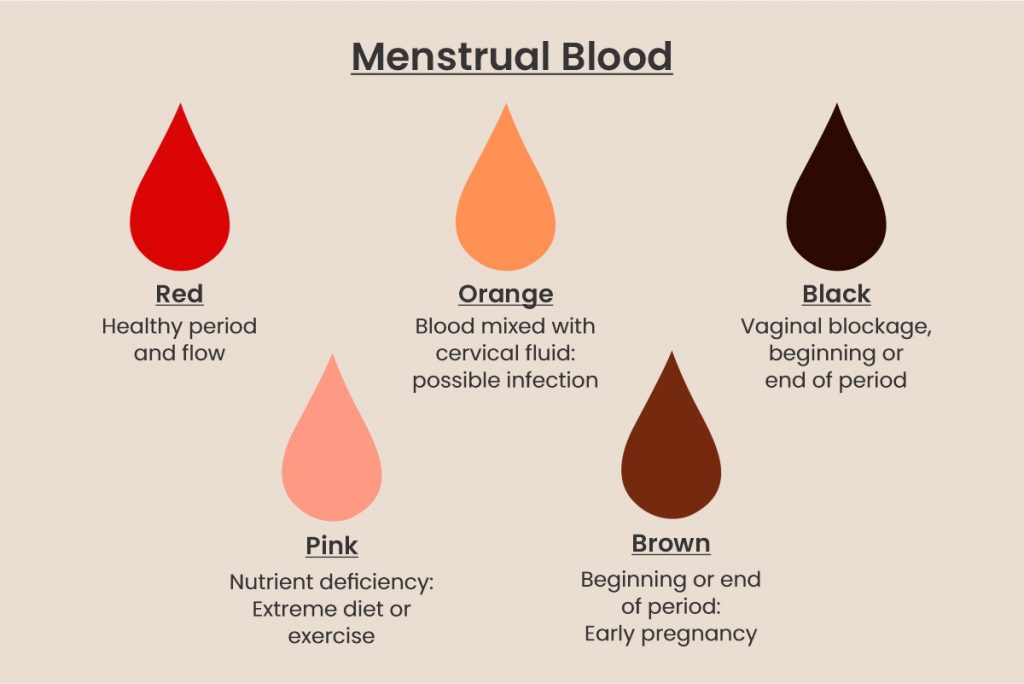Bleeding is such an inseparable and important aspect of a woman’s life as it marks the beginning of womanhood. From the day you get your first period, the red flow becomes your period companion for those 4-5 days every month. But you may have noticed that your period blood, also known as menstrual discharge or menses, is not always red!
Sometimes it is watery and pinkish, sometimes it’s thick and reddish, and sometimes you may see brown or black period blood! You may be wondering why the colour and texture of your period blood vary on different days.
The first thing you should know about changes in your period blood color is that it’s fairly normal and not an illness or a magic trick! Some normal biochemical processes in your body cause the blood to change its hue when it flows through your uterus.
Why is the colour of your period blood not red all the time?
Your menstrual cycle is controlled by hormones. Hormones regulate the thickening of the lining of your uterus, also known as the endometrium. When your menstrual cycle begins, hormonal changes cause the endometrium to break down and separate from the wall of the uterus.
The excess blood and separated tissue flow down through the cervix and out through the vagina. This mixture of blood and tissue is what makes up your period blood. The color and texture of your menstrual blood depend on the ratio and amount of this mixture.
What do these colours indicate about your health?
The shade of your menstrual discharge provides some vital information about what’s going on inside your body. The below chart provides a brief idea of what you can know from the different colours of your period blood.

Brown or Dark Red
Blood that takes longer to leave your uterus tends to be brown or dark red in color. Your vagina has an acidic pH and at the beginning or end of the menstrual cycle, the period blood that reacts to the acidity in the vagina turns brown or dark red. Technically, it’s the old blood that spent a longer time in the uterus than usual, long enough to oxidize and change its colour.
Health Signs
If you observe brown blood or spotting, it might be a sign of early pregnancy. Doctors refer to it as implantation bleeding, which happens when the fertilized egg attaches to the lining of the uterus.
Dark brown spotting or bleeding during pregnancy can indicate a miscarriage or an ectopic pregnancy. It happens when a fertilized egg lodges in a fallopian tube or other location instead of continuing its journey to the uterus. In this case, you should consult a doctor.
After 4 to 5 weeks of delivering a baby, you might see dark red or brown blood discharge. It is called lochia or postpartum bleeding. Lochia is not a matter of concern if you are not experiencing heavy bleeding. If you are, it’s advisable to talk to your gynec.
Bright Red
You may see a bright red discharge at the beginning of your periods. Bright red means it is your fresh blood that’s flowing quickly. As it’s just the beginning of your cycle, the blood hasn’t spent enough time in the uterus to oxidize and change its colour. You might see bright red discharge during your entire cycle which may turn darker towards the end of your period.
Health Signs
If you observe unusual bleeding or spotting between your menstrual cycles, it may be a sign of sexually transmitted infection like chlamydia or gonorrhea. It’s a bacterial infection and can be easily treated with prescribed antibiotics.
Unusual heavy bleeding may also be caused by the noncancerous growths in the uterine lining, called polyps or fibroids. Sometimes these tumors may cause severe abdominal pain or cramps and in some cases, they may not cause any signs or symptoms.
Pink
Some women may notice light pinkish flow at the very beginning or towards the end of their cycle due to multiple reasons. The pink shade can be the result of blood mixing with vaginal mucus or cervical fluid.
Health Signs
If you use hormonal birth control, it may lower estrogen levels in your body, leading to a lighter flow with a pinkish hue.
It’s also possible that during sexual intercourse, your vagina or the cervix may have gotten small tears. Blood flowing from these tears can mix with vaginal fluids and come out as pink discharge.
If you experience a gush of vaginal discharge during pregnancy, it may indicate a miscarriage. In this case, you should consult a gynecologist.
Orange
Probably it’s the rarest of the colours. This lighter hue of period blood is caused due to the same process that makes your blood pinkish. When cervical fluid dilutes blood, it can also appear orange.
Health Signs
Orange discharge or spotting can often be a sign of infection, such as bacterial vaginosis or trichomoniasis. This infection occurs when there is an imbalance between beneficial and harmful bacteria in the vagina. With orange discharge, if you also experience foul-smelling discharge or vaginal itching, you should see a doctor and discuss your symptoms to ensure your body is healthy.
Gray
Gray discharge can be noticed most commonly at the beginning or towards the end of your period. It’s typically the blood that took longer to leave your uterus, got oxidized and became darker.
Health Signs
Gray or off-white period blood can be a cause of concern. Like orange, gray blood can also indicate an infection like bacterial vaginosis. Along with gray discharge, if you feel vaginal itching, smelly vaginal odour, or a burning sensation when you use the toilet, you should see a gynecologist find out the possible causes.
Black
Black flow can appear during the start or end of your menstrual cycle and as you might have figured out, it’s black because it may have taken more time to leave the uterus, enough to oxidize and pick up a tone similar to coffee grounds.
Health Signs
Usually, black discharge is nothing to worry about as it may be just the old blood of the cycle. However, sometimes black blood can be a sign of a blockage inside the vagina. If you notice symptoms like difficulty in urinating, foul-smelling discharge and fever, you should chat with your doctor to make sure everything is fine.
By now, you must have understood how important it is to stay aware of what your body is trying to tell you. Just remember that all women are unique, so do their periods, Therefore, there is no single blueprint for all. You need to learn to pick up the little signs during your menstruation. It will not only help you stay healthy but also ensure, if something is wrong, you know you need to go and check with your doctor.







